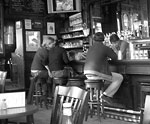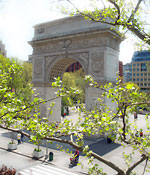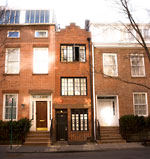The Writing Life
Downtown, New York’s Literary Scene is Past and Prologue
By Nicole Pasulka The writer is an editor for The Morning News. Her work has also appeared in Bust Magazine, The Globe and Mail and Salon.com.
When people learn I’m a writer and editor, that I work for magazines and book publishers (folding nearly at the rate of investment firms lately), and that, despite all this dwindling opportunity, I still live in New York City, the response is usually cautious, pitying concern:
“I haven’t read a magazine in years. I thought they’d all just moved to the Internet.” Now I know who to blame for slashed freelance budgets.
“How can you afford to live in that place? Hasn’t it been taken over by real estate moguls and the models that date them?” Shifting awkwardly, I try to conceal my patched jeans and scuffed shoes.
People have been whining, “New York isn’t what it used to be,” ever since Central Park was a swamp.
I’d be lying if I said New York City arts and literary communities haven’t suffered losses recently. Performance spaces, galleries, and non-profits struggle to stay afloat, and often capsize due to a lack of funding or customers’ own wrecked finances. A little fear and pessimism are understandable. But before we all jump ship in search of the next “scene,” it’s worth mentioning that people have been whining, “New York isn’t what it used to be,” since Central Park was a swamp. And no neighborhood holds more promise and disappoints more frequently than Greenwich Village.
Though New York City, like the notion of a thriving literary culture, is dogged by persistent rumors of decline and death, my recent walks through Chelsea and Greenwich Village proved both are alive and well in spite of whatever’s happening on Wall Street or Madison Avenue. Sure, it’s not the same as it used to be. E.B. White’s 60-year-old observation that New York City is “both changeless and changing” still rings true. When I pass the White Horse Tavern where Dylan Thomas had his last drink, and Mark Twain’s house at 14 West 10th Street, on my way to hear Sherman Alexie read at the Poetry Project at St. Mark’s Church, I feel “the vibrations of great times and tall deeds, of queer people and events and undertakings” that White described. The Antiquarian Book Fair (at the Park Avenue Armory, April 3-5), a celebration of objects whose current and future value are widely debated right now is the perfect opportunity to reflect on these past and present literary undertakings.
Few understand how the West Village’s present cohabits with its past better than tour guide and educator Joyce Gold. On Sunday, April 5, through the Greenwich Village Historical Preservation Society, Gold will give a tour of Washington Square Park focused on Henry James’ relationship to the setting and namesake of his novel. Gold explained to me that she’s “fascinated with the attraction of Washington Square and the Village.” That fascination echoes James’ own assertion, in Washington Square, that for the characters, “it was here…that you had come into the world.” Since the novel was published in 1880, the West Village and the Square may have come to represent high-art rather than high-society, but regardless of the crowd, the neighborhood seduces both natives and settlers with the promise of higher living.
The ghosts of hundreds of other writers and artists call Greenwich Village home. Despite astronomical rents and tipsy New York University students crowding the cobble stone streets, I can imagine Edna St. Vincent Millay typing furiously in the “narrowest house in New York,” at 75 1/2 Bedford Street, or Jack Kerouac drinking himself blind at the San Remo bar on MacDougal street. Except today Edna St. Vincent Millay would have to give up poetry for copywriting in order to afford the rent at even that constricted space and, rather than a stiff drink, all I find at 189 MacDougal Street is an abandoned Pan-Asian restaurant.










